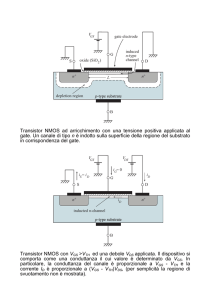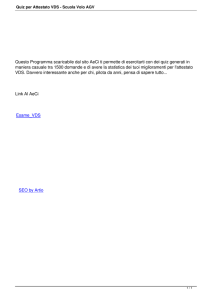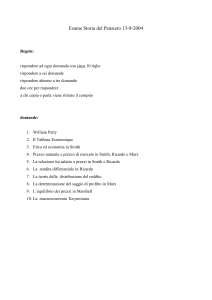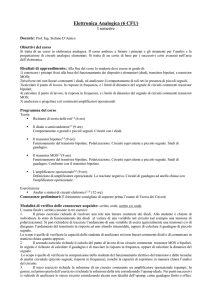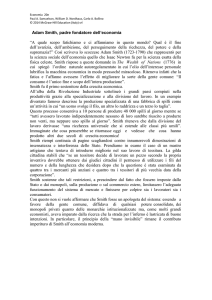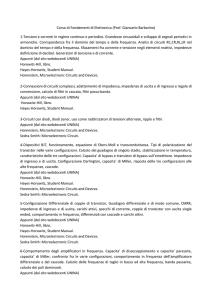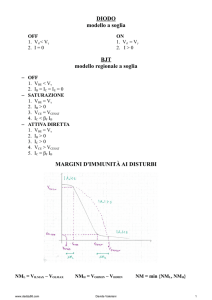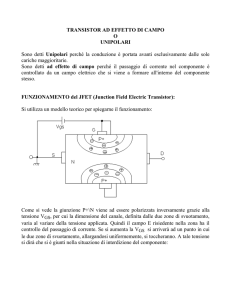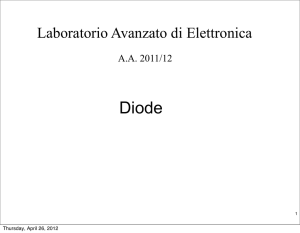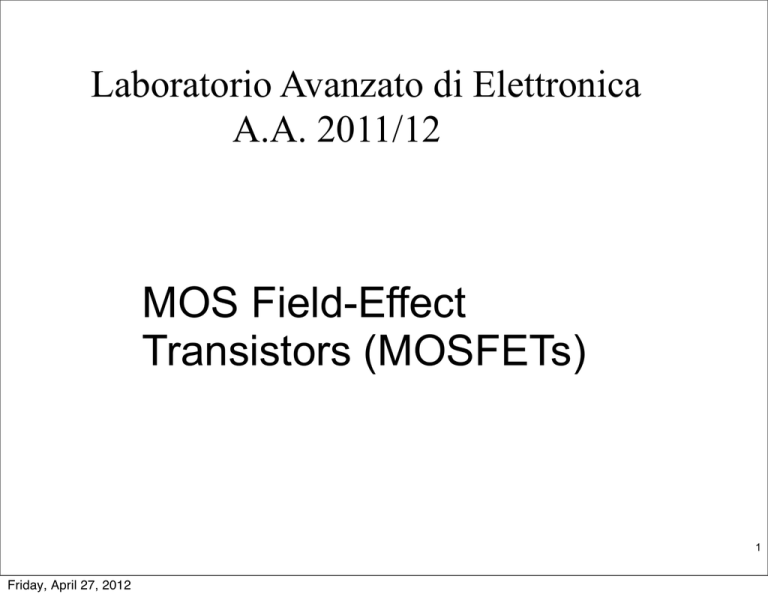
Laboratorio Avanzato di Elettronica
A.A. 2011/12
MOS Field-Effect
Transistors (MOSFETs)
1
Friday, April 27, 2012
Figure 4.1 Physical structure of the enhancement-type NMOS transistor: (a) perspective view; (b) cross-section. Typically L =
0.1 to 3 µm, W = 0.2 to 100 µm, and the thickness of the oxide layer (tox) is in the range of 2 to 50 nm.
Microelectronic Circuits - Fifth Edition
Friday, April 27, 2012
Sedra/Smith
Copyright © 2004 by Oxford University Press, Inc.
2
La vGS che forma il canale di conduzione e’ chiamata
tensione di soglia vt , compresa tra 0.5 ed 1 V
Induced channel= inversion layer
Il gate ed il canale formano un condensatore, con l’ossido come dielettrico.
Applicando una piccola tensione positiva sul gate si accumulano cariche
positivee nel canale cariche negative, rendendo la regione conduttiva.
Figure 4.2 The enhancement-type NMOS transistor with a positive voltage applied to the gate.
An n channel is induced at the top of the substrate beneath the gate.
Microelectronic Circuits - Fifth Edition
Friday, April 27, 2012
Sedra/Smith
Copyright © 2004 by Oxford University Press, Inc.
3
Come funziona il MOS con piccola VDS
Figure 4.3 An NMOS transistor with vGS > Vt and
with a small vDS applied. The device acts as a
resistance whose value is determined by vGS.
Specifically, the channel conductance is proportional
to vGS – Vt’ and thus iD is proportional to (vGS – Vt) vDS.
Note that the depletion region is not shown (for
simplicity).
Microelectronic Circuits - Fifth Edition
Friday, April 27, 2012
Sedra/Smith
Figure 4.4 The iD–vDS characteristics of the
MOSFET in Fig. 4.3 when the voltage applied
between drain and source, vDS, is kept small. The
device operates as a linear resistor whose value is
controlled by vGS.
Copyright © 2004 by Oxford University Press, Inc.
4
Al crescere di VDS
Figure 4.5 Operation of the enhancement NMOS
transistor as vDS is increased. The induced channel
acquires a tapered shape, and its resistance increases as
vDS is increased. Here, vGS is kept constant at a value > Vt.
Microelectronic Circuits - Fifth Edition
Friday, April 27, 2012
Sedra/Smith
Figure 4.6 The drain current iD versus the drainto-source voltage vDS for an enhancement-type
NMOS transistor operated with vGS > Vt.
Copyright © 2004 by Oxford University Press, Inc.
5
Figure 4.7 Increasing vDS causes the channel to acquire a tapered shape.
Eventually, as vDS reaches vGS – Vt’ the channel is pinched off at the drain
end. Increasing vDS above vGS – Vt has little effect (theoretically, no effect)
on the channel’s shape.
Microelectronic Circuits - Fifth Edition
Friday, April 27, 2012
Sedra/Smith
Copyright © 2004 by Oxford University Press, Inc.
6
Relazione tra ID e VDS
carica elettronica in dx
Figure 4.8 Derivation of the iD–vDS characteristic of the NMOS transistor.
Microelectronic Circuits - Fifth Edition
Friday, April 27, 2012
Sedra/Smith
Copyright © 2004 by Oxford University Press, Inc.
7
La tensione vDS produce un campo elettrico lungo il canale nella direzione negativa
la carica dq drifta con velocita’
corrente di drift
corrente di canale
Microelectronic Circuits - Fifth Edition
Friday, April 27, 2012
Sedra/Smith
Copyright © 2004 by Oxford University Press, Inc.
8
l’integrazione della relazione tra i limiti x=0 e x=L e
conseguentemente per v(0)=0 e v(L)= vDS porta alla relazione base
Espressione per la iD-vDS nella regione triodo
all’inizio della regione saturazione si ha vDS = vGS - Vt e l’espressione diventa , a
meno di un fattore 1/2
dove si vede che id rimane costante per un dato vGS
questo significa che per ogni valore di vGS ci sara’una curva caratteristica ed un valore di corrente di saturazione
e’ un parametro che dipende dalla tecnologia usata per fabbricare il n-channel, e’ chiamato
process transconductance parameter e si misura in A/V2
i valori in gioco sono approssimativamente per un MOSFET
per Cox circa decina di fF/um2
per un circa centinaia di uA/V2
con W/L circa 10 per un canale di 0.8 um
Microelectronic Circuits - Fifth Edition
Friday, April 27, 2012
Sedra/Smith
Copyright © 2004 by Oxford University Press, Inc.
9
Complementary MOS o CMOS
Figure 4.9 Cross-section of a CMOS integrated circuit. Note that the PMOS transistor is formed in a separate n-type
region, known as an n well. Another arrangement is also possible in which an n-type body is used and the n device is
formed in a p well. Not shown are the connections made to the p-type body and to the n well; the latter functions as the
body terminal for the p-channel device.
Microelectronic Circuits - Fifth Edition
Friday, April 27, 2012
Sedra/Smith
Copyright © 2004 by Oxford University Press, Inc.
10
Caratteristica iD-vDS
per un n-channel MOS
Figure 4.10 (a) Circuit symbol for the n-channel enhancement-type MOSFET. (b) Modified
circuit symbol with an arrowhead on the source terminal to distinguish it from the drain and to
indicate device polarity (i.e., n channel). (c) Simplified circuit symbol to be used when the
source is connected to the body or when the effect of the body on device operation is
unimportant.
Microelectronic Circuits - Fifth Edition
Friday, April 27, 2012
Sedra/Smith
Copyright © 2004 by Oxford University Press, Inc.
11
Figure 4.11 (a) An n-channel enhancement-type MOSFET with vGS and vDS applied and with
the normal directions of current flow indicated. (b) The iD–vDS characteristics for a device with
k’n (W/L) = 1.0 mA/V2.
per vDS piccola si trascura il contributo di v2DS e la relazione per la zona triodo diventa
Per vGS fissato la relazione iD-vDS e’ lineare: il MOS si comporta come una resistenza controllata da vGS
e la resistenza rDS
Microelectronic Circuits - Fifth Edition
Friday, April 27, 2012
Sedra/Smith
Copyright © 2004 by Oxford University Press, Inc.
12
Per lavorare nella regione di saturazione il MOS deve indurre un canale VGS >=Vt
( canale indotto) e chiudere ( pinch off) il canale sul DRAIN alzando VDS tale che
vGD<=Vt ( pinched off channel).
In sostanza si deve avere
la regione tra triodo e saturazione e’ caratterizzata da
per cui sostituendo si ricava la relazione per la
corrente di saturazione
IL MOS si comporta come una
sorgente ideale di corrente controllata
da una VGS ,
secondo una relazione quadratica.
Figure 4.12 The iD–vGS characteristic for an enhancement-type NMOS transistor in saturation (Vt = 1 V, k’n W/L = 1.0
mA/V2).
Il comportamento e’ quindi quello di un modello di circuito equivalente per large signal
Microelectronic Circuits - Fifth Edition
Friday, April 27, 2012
Sedra/Smith
Copyright © 2004 by Oxford University Press, Inc.
13
Figure 4.13 Large-signal equivalent-circuit model of an n-channel MOSFET operating in the saturation region.
Microelectronic Circuits - Fifth Edition
Friday, April 27, 2012
Sedra/Smith
Copyright © 2004 by Oxford University Press, Inc.
14
Figure 4.14 The relative levels of the terminal voltages of the enhancement NMOS transistor for operation in the triode
region and in the saturation region.
Microelectronic Circuits - Fifth Edition
Friday, April 27, 2012
Sedra/Smith
Copyright © 2004 by Oxford University Press, Inc.
15
Resistenza finita di output in saturazione
In saturazione iD e’ indipendenta da vDS, cosi’ un cambiamento DvDS NON causa una variazione in iD,
che implica che la resistenza incrementale, vista al drain, di un MOS saturato e‘ infinita.
Figure 4.15 Increasing vDS beyond vDSsat causes the channel pinch-off point to move slightly away from the drain, thus
reducing the effective channel length (by DL).
MA aumentando vDS>vDSsat=vGS-Vt si restringe il canale e si ha un effetto di Channel modulation e
poiche’ la iD dipende dalla lunghezza del canale, cio’ fa si’ che iD cresca al crescere con vDS.
Microelectronic Circuits - Fifth Edition
Friday, April 27, 2012
Sedra/Smith
Copyright © 2004 by Oxford University Press, Inc.
16
Tenendo conto della variazione della lunghezza L del canale
la relazione di iD diventa
parametro dipendente dalla tecnologia
ha dimensioni di V
Figure 4.16 Effect of vDS on iD in the saturation region. The MOSFET parameter VA depends on the process technology
and, for a given process, is proportional to the channel length L.
Microelectronic Circuits - Fifth Edition
Friday, April 27, 2012
Sedra/Smith
Copyright © 2004 by Oxford University Press, Inc.
17
ne segue che la resistenza di output della sorgente di corrente iD
non e’ piu’ infinita.
Output Resistance
inversamente proporzionale \corrente di drain
Corrente di drain senza modulazione
Figure 4.17 Large-signal equivalent circuit model of the n-channel MOSFET in saturation, incorporating the output
resistance ro. The output resistance models the linear dependence of iD on vDS and is given by Eq. (4.22).
Microelectronic Circuits - Fifth Edition
Friday, April 27, 2012
Sedra/Smith
Copyright © 2004 by Oxford University Press, Inc.
18
p-channel MOSFET
Valgono le stesse
relazioni del n-channel
MOS solo che , vGS,Vt,e
VDS sono tutte negative
Figure 4.18 (a) Circuit symbol for the p-channel enhancement-type MOSFET. (b) Modified symbol with an arrowhead on the source
lead. (c) Simplified circuit symbol for the case where the source is connected to the body. (d) The MOSFET with voltages applied and
the directions of current flow indicated. Note that vGS and vDS are negative and iD flows out of the drain terminal.
Microelectronic Circuits - Fifth Edition
Friday, April 27, 2012
Sedra/Smith
Copyright © 2004 by Oxford University Press, Inc.
19
Figure 4.19 The relative levels of the terminal voltages of the enhancement-type PMOS transistor for operation in the triode region
and in the saturation region.
Microelectronic Circuits - Fifth Edition
Friday, April 27, 2012
Sedra/Smith
Copyright © 2004 by Oxford University Press, Inc.
20
Figure E4.8
Microelectronic Circuits - Fifth Edition
Friday, April 27, 2012
Sedra/Smith
Copyright © 2004 by Oxford University Press, Inc.
21
Table 4.1
Microelectronic Circuits - Fifth Edition
Friday, April 27, 2012
Sedra/Smith
Copyright © 2004 by Oxford University Press, Inc.
22
IL MOSFET come amplificatore e switch
Figure 4.26 (a) Basic structure of the common-source amplifier. (b) Graphical construction to determine the transfer characteristic of
the amplifier in (a).
Microelectronic Circuits - Fifth Edition
Friday, April 27, 2012
Sedra/Smith
Copyright © 2004 by Oxford University Press, Inc.
23
Caratteristica di trasferimento
Figure 4.26 (Continued) (c) Transfer characteristic showing operation as an amplifier biased at point Q.
Microelectronic Circuits - Fifth Edition
Friday, April 27, 2012
Sedra/Smith
Copyright © 2004 by Oxford University Press, Inc.
24
Operazione come amplificatore lineare
Il punto di lavoro Q , o quiescent point, e’ scelto a meta’ del segmento saturazione nella curva di transfer.
Questo per avere uno swing del segnale massimo.
Lavorando nella zona lineare della funzione di transfer, con un segnale
vi sufficientemente piccolo si avra’ un segnale vo proporzionale a vi,
con un guadagno Av
Figure 4.27 Two load lines and corresponding bias points. Bias point Q1 does not leave sufficient room for positive signal
swing at the drain (too close to VDD). Bias point Q2 is too close to the boundary of the triode region and might not allow for
sufficient negative signal swing.
Microelectronic Circuits - Fifth Edition
Friday, April 27, 2012
Sedra/Smith
Copyright © 2004 by Oxford University Press, Inc.
25
Espressione analitica per la caratteristica di transfer
1) Regione di cut off
2) Regione di di saturazione
Il guadagno sara’
o in un’altra espressione
con VRD = tensione DC ai capi di RD
l’end-point della regione saturazione e’ caratterizzato
Microelectronic Circuits - Fifth Edition
Friday, April 27, 2012
Sedra/Smith
Copyright © 2004 by Oxford University Press, Inc.
26
3) regione triodo
se vo e’ piccolo
da cui si ricava
si ottiene la relazione usabile
Microelectronic Circuits - Fifth Edition
Friday, April 27, 2012
Sedra/Smith
Copyright © 2004 by Oxford University Press, Inc.
27
Biasing nei circuiti MOS
Figure 4.29 The use of fixed bias (constant VGS) can result in a large variability in the value of ID. Devices 1 and 2
represent extremes among units of the same type.
Microelectronic Circuits - Fifth Edition
Friday, April 27, 2012
Sedra/Smith
Copyright © 2004 by Oxford University Press, Inc.
28
Biasing nei circuiti amplificatori MOS
Biasing fissando VGS , soluzione non favorita,
perche’ transistori non tutti uguali anche tra stesso tipo
Biasing fissando VG , soluzione favorita, si aggiusta
il valore caso per caso
Agisce come feedback negativo
Figure 4.30 Biasing using a fixed voltage at the gate, VG, and a resistance in the source lead, RS: (a) basic arrangement; (b)
reduced variability in ID; (c) practical implementation using a single supply; (d) coupling of a signal source to the gate
using a capacitor CC1; (e) practical implementation using two supplies.
Microelectronic Circuits - Fifth Edition
Friday, April 27, 2012
Sedra/Smith
Copyright © 2004 by Oxford University Press, Inc.
29
Biasing con una resistenza di feedback tra Drain e Gate
RD agisce come resistenza
di feedback negativo
Il segnale al Gate non disturba
la VGS e puo’ essere usato
come un CS amplifier.
Ha una limitazione nel fatto che lo swing del segnale in output
non puo’ essere molto esteso
Figure 4.32 Biasing the MOSFET using a large drain-to-gate feedback resistance, RG.
Microelectronic Circuits - Fifth Edition
Friday, April 27, 2012
Sedra/Smith
Copyright © 2004 by Oxford University Press, Inc.
30
Biasing con CONSTANT CURRENT SOURCE
Modo piu’ efficace
. RG , ~ M Ohm, assicura un dc ground ed una alta resistenza in input
. RD fissa un valore a V assicurando un largo swing al segnale in uscita
ed assicurando che il MOS sia in saturazione
Circuito per
implementare un CCS
D
Circuito MIRROR CURRENT
specchio di corrente
Figure 4.33 (a) Biasing the MOSFET using a constant-current source I. (b) Implementation of the constant-current source I
using a current mirror.
Microelectronic Circuits - Fifth Edition
Friday, April 27, 2012
Sedra/Smith
Copyright © 2004 by Oxford University Press, Inc.
31
Small signal amplifier models
Il segnale vgs e’ sovrapposto al DC bias VGS, assunto fisso.
Il punto di bias DC sara’ scelto in
modo da permettere lo swing del
segnale
Per avere saturazione
ma deve essere abbastanza grande da
assicurare lo swing del segnale
Figure 4.34 Conceptual circuit utilized to study the operation of the MOSFET as a small-signal amplifier.
Microelectronic Circuits - Fifth Edition
Friday, April 27, 2012
Sedra/Smith
Copyright © 2004 by Oxford University Press, Inc.
32
Il segnale di corrente sul terminale Drain
Applicando un segnale vgs
la corrente di Drain istantanea sara’
sviluppando compare un termine
vgs**2
non lineare
Per ridurre l’effetto deve essere
cosi’
i vgs e’ la transconduttanza gm
il parametro che lega d a
Figure 4.35 Small-signal operation of the enhancement MOSFET amplifier.
Microelectronic Circuits - Fifth Edition
Friday, April 27, 2012
Sedra/Smith
Copyright © 2004 by Oxford University Press, Inc.
33
Guadagno in tensione
per piccoli segnali
in termini di
gm
e il guadagno in tensione
il segno - indica un output
con la fase invertita
Figure 4.36 Total instantaneous voltages vGS and vD for the circuit in Fig. 4.34.
Microelectronic Circuits - Fifth Edition
Friday, April 27, 2012
Sedra/Smith
Copyright © 2004 by Oxford University Press, Inc.
34
Figure 4.37 Small-signal models for the MOSFET: (a) neglecting the dependence of iD on vDS in saturation (the channel-length
modulation effect); and (b) including the effect of channel-length modulation, modeled by output resistance ro = |VA| /ID.
Microelectronic Circuits - Fifth Edition
Friday, April 27, 2012
Sedra/Smith
Copyright © 2004 by Oxford University Press, Inc.
35
Single stage MOS amplifier
Figure 4.42 Basic structure of the circuit used to realize single-stage discrete-circuit MOS amplifier configurations.
Microelectronic Circuits - Fifth Edition
Friday, April 27, 2012
Sedra/Smith
Copyright © 2004 by Oxford University Press, Inc.
36
Common Source amplifier
Figure 4.43 (a) Common-source amplifier based on the circuit of Fig. 4.42. (b) Equivalent circuit of the amplifier for
small-signal analysis. (c) Small-signal analysis performed directly on the amplifier circuit with the MOSFET model
implicitly utilized.
Microelectronic Circuits - Fifth Edition
Friday, April 27, 2012
Sedra/Smith
Copyright © 2004 by Oxford University Press, Inc.
37
CS amplifier
Caratteristiche di un CS amplifier: input resistance, voltage gain, output resistance
Dal modello a piccoli segnali del MOS
Microelectronic Circuits - Fifth Edition
Friday, April 27, 2012
Sedra/Smith
Copyright © 2004 by Oxford University Press, Inc.
38
Common Gate amplifier
Input signal sul source, output al drain.
Figure 4.45 (a) A common-gate amplifier based on the circuit of Fig. 4.42. (b) A small-signal equivalent circuit of the
amplifier in (a). (c) The common-gate amplifier fed with a current-signal input.
Microelectronic Circuits - Fifth Edition
Friday, April 27, 2012
Sedra/Smith
Copyright © 2004 by Oxford University Press, Inc.
39
Dal circuito si nota che
ma per non avere riduzione del
segnale in input
la corrente
cosi’ l’output si puo’ trovare come
e a circuito aperto
da cui il guadagno
Il guadagno totale del circuito
e la resistenza di output e’
Microelectronic Circuits - Fifth Edition
Friday, April 27, 2012
Sedra/Smith
Copyright © 2004 by Oxford University Press, Inc.
40
in conclusione
Confrontando il Common Source ed il
Common Gate si puo’ dire che:
1.Diversamente dal CS il CG e’ non-invertente
2. Il CS amplifier ha una alta resistenza di input, il CG
amplifier ha una bassa resistenza di input
3. Mentre i valori di Av sia del CS che CG sono simili, il
guadagno totale del CG e’ minore di un fattore 1+gmRsig
che e’ dovuto alla piccola resistenza di input del circuito CG.
Il CG avendo una bassa resistenza di input ed una alta resistenza
di output agisce come un UNITY GAIN CURRENT AMPLIFIER
o CURRENT FOLLOWER
Microelectronic Circuits - Fifth Edition
Friday, April 27, 2012
Sedra/Smith
Copyright © 2004 by Oxford University Press, Inc.
41
Figure 4.49 (a) Capacitively coupled common-source amplifier. (b) A sketch of the frequency response of the amplifier in
(a) delineating the three frequency bands of interest.
Microelectronic Circuits - Fifth Edition
Friday, April 27, 2012
Sedra/Smith
Copyright © 2004 by Oxford University Press, Inc.
42
Figure 4.50 (Continued) (c) the equivalent circuit with Cgd replaced at the input side with the equivalent capacitance Ceq;
(d) the frequency response plot, which is that of a low-pass single-time-constant circuit.
Microelectronic Circuits - Fifth Edition
Friday, April 27, 2012
Sedra/Smith
Copyright © 2004 by Oxford University Press, Inc.
43
Figure 4.52 Sketch of the low-frequency magnitude response of a CS amplifier for which the three break frequencies are
sufficiently separated for their effects to appear distinct.
Microelectronic Circuits - Fifth Edition
Friday, April 27, 2012
Sedra/Smith
Copyright © 2004 by Oxford University Press, Inc.
44

